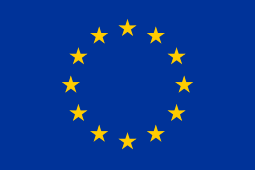Flag of EU
 |
|
| Proportion | 2:3 |
|---|---|
| Adopted | 8 December 1955 (CoE) 29 June 1985 (EEC) |
| Design | A circle of twelve five-pointed yellow stars in a blue field. |
| Designed by | Arsène Heitz, Paul M. G. Lévy |
The Flag of Europe, or European Flag is an official symbol of two separate organizations—the Council of Europe (CoE) and the European Union (EU). When representing the latter, it is also known as the Flag of the European Union. It consists of a circle of twelve five-pointed yellow (gold) stars on a blue (azure) field.
The flag was designed in 1955, and officially launched later that year by the Council of Europe as a symbol for the whole of Europe. The Council of Europe urged it to be adopted by other European organisations, and in 1985 the European Communities (EC) adopted it.
The EU has inherited the flag's use when it was formed in 1993, being the successor organisation to the EC. It has been in wide official by the EU since the 1990s, but it has never been given official status in any of the EU's treaties. Its adoption as an official symbol of the EU was planned as part of the proposed European Constitution, which failed to be ratified in 2005.
Since its adoption by the European Union, it has become broadly associated with the supranational organisation due to its high profile and heavy usage of the emblem. It has also been used by pro-EU protestors in the colour revolutions of the 2000s, e.g. in Belarus (2004) or Moldova. There are also a number of derivative designs used as logos or flags of other European organisations, and in the flags of the Republic of Kosovo (2008) and of Bosnia and Herzegovina (1998).
The flag is rectangular with 2:3 proportions: its fly (width) is one and a half times the length of its hoist (height). Twelve gold (or yellow) stars are centred in a circle (the radius of which is a third of the length of the hoist) upon a blue background. All the stars are upright (one point straight up), have five points and are spaced equally according to the hour positions on the face of a clock. The diameter of each star is equal to one-ninth of the height of the hoist.
...
Wikipedia
